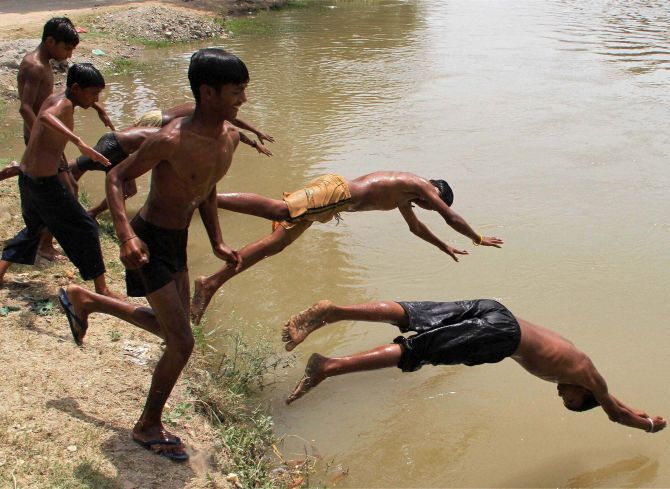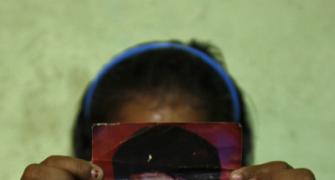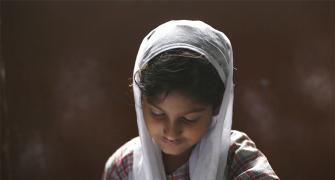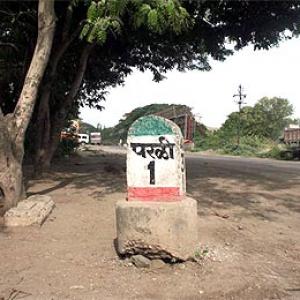'... because their parents wanted a boy.'
'But over 2 million women go every year due to sex-selective abortion, disease, neglect or inadequate nutrition,' says Devangshu Datta.

IMAGE: In 1991, Amartya Sen reckoned that there were about 40 million 'missing' women, based on skew in the gender ratio.
By 2011, that figure of missing women had risen to 63 million. Photograph: Mansi Thapliyal/Reuters
Legendary puzzler Martin Gardner once posed two related questions: First, Mr Smith has two children. The older is a girl. What is the probability that both children are girls?
Second, Mr Jones has two children, at least one of whom is a boy. What is the probability the other Jones kid is also a boy?
The birth of a boy or a girl is (almost) equally likely.
Under normal circumstances, 105 boys are born for every 100 girls.
If we approximate to a birth ratio of 1:1 (assuming no transgender births), the first answer is deduced fairly easily.
There exist four equally likely possibilities for any sequence of two births.
These are girl first, then another girl (GG), girl-boy (GB), boy-girl (BG) and boy-boy (BB).
Since, the two sequences beginning with a boy are ruled out, there's a 50 per cent chance there will be two girls.
The second question is trickier. The order of birth is unknown.
But one of the four possibilities -- GG -- is ruled out. So, BB is a one in three chance (33.3 per cent).
Looking at those four combinations, you may note that the ratio is 4:4.
Extend the sequence to families with three children (starting with either boy or girl). The third child could be of either gender.
Now, there are eight equally likely possibilities comprising a set of GGG, GGB, GBG. GBB, BBG, BBB, BGG, BGB.
The gender ratio will remain the same for a large number of families. Whether they have one kid or two kids or three kids or more, the sex ratio at birth should approximate out at near 105 boys to 100 girls.
What's more the sex ratio for the first child, second child, third child, etc, will also be close to 105:100.
Unless there's human intervention.
Chapter Seven of Volume-I of the Economic Survey 2017-18 titled Gender and Son Meta-Preference: Is Development Itself an Antidote? bases a lot of analysis and extrapolation around that basic insight.
A disturbance of the normal gender ratio implies some human intervention. This could be selective abortion or infanticide or more subtle.

IMAGE: As the ban on sex determination tests is enforced, the preference for boys showed up in a different way. The sex-ratio of the last child born in Indian families became excessively skewed. Photograph: PTI
India, as everyone knows, has a skewed gender ratio.
In 1991, Amartya Sen reckoned that there were about 40 million 'missing' women, based on skew in the gender ratio.
By 2011, that figure of missing women had risen to 63 million.
Interestingly, as sex determination tests were banned and bans were actually enforced, the preference for boys has showed up in a different way.
The sex-ratio of the last child born in Indian families is excessively skewed.
At the national level, it is around 9.5 per cent worse than it should be, compared to other countries at similar levels of development.
In Gujarat, Punjab and Rajasthan, the SRLC is 2,100 boys for every 1,000 girls.
In Haryana, it is even worse at 2,300 boys: 1,000 girls.
The inescapable inference: Indian families carry on having kids until there is a boy and then, they stop having kids.
The Survey calls this a 'meta preference' and a 'fertility stopping rule'.
It makes the inference that there are 21 million unwanted girls, who were born because their parents wanted a boy.
It also claims that over two million women go missing across age groups annually due to sex-selective abortion, disease, neglect or inadequate nutrition.
It's axiomatic that women's empowerment, education and agency in terms of deployment of their income, travel, etc, can lead to a big leap forward.
Indeed, these things are desirable in themselves, quite apart from large positive externalities.
For example, the International Monetary Fund reckons that equal participation by women in the labour force could push up the gross domestic product by 27 per cent.
Sadly, the Survey shows that development, higher income, education, et al don't necessarily lead to commensurate improvement.
The states with the best gender ratios are the north eastern sisters, which are low on income and other development indices.
This is a civilisational problem of huge dimensions.
Indeed, the absence of that 63 million, and the likely maltreatment of the 21 million unwanted girls, makes one wonder if India can claim to be civilised.











